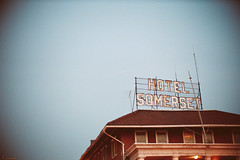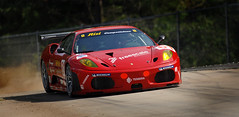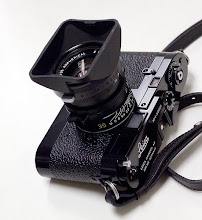Shot with the Noctilux - it really is one of my favorite lenses in the Leica M system. The signage here seems so displaced today...but to me, that's what draws me to it. Note the vignetting on the corners of the image - that is a characteristic of the lens, which was really designed for use by available light shooters when film had an ISO of 400 basically. Used in a concert or stage setting - the edges might not be as noticeable. Shot wide open at F1.0 - this is a typical "look" from the Noctilux.
I've been shooting quite a number of weddings lately, all digital - and much of the portrait work I'm doing of the bride & groom is typically shot with an 85/1.4 or 135/2 Nikkor. These lenses also provide outstanding image quality wide open.
Tuesday, October 21, 2008
Tuesday, August 12, 2008
Portait Work
This is an older image, likely shot with an 85mm Nikkor on Tri-X. Aperture was probably in the 2.8 range based on what's in focus. These days, I might have used even less depth of field, but in this image - the sharp areas work well in contrast to how blurred the background is. For much of my portrait work, i really enjoy using this effect to seperate the subject from the background. In many cases, outddoor backgrounds can be fairly busy, but using shallow depth of field can transform any area and isolate the main subject matter as needed to really make things stand out. Used in the spring or fall with color, it can really make for nice images.
Tuesday, August 5, 2008
Action Shots & Depth Of Field
The American LeMans Ferrari photo, taken at Limerock Park in July of 2007, was shot with a Nikon D2X and a Nikkor 300/2.8. For sporting events, and even portraiture – long telephotos can be effectively used to isolate subject matter, especially at wide open apertures. This particular image was shot at F 3.2, 1/3000 of a second.
One thing I really like to do is blur the background in camera, before it ever gets near a computer or Photoshop for that matter. The slight vignetting seen here is a slight edge burn in Photoshop to draw attention to the main visual, the car. This, in addition to using Depth of Field (dof) as a tool, clearly adds to the impact.
One tip for those with an aperture priority setting on their cameras – is to experiment using the widest aperture you have on the lens, and see what happens to your images and subject matter. If your using an older camera, or even one that’s fully manual, simply select the widest aperture and meter accordingly with the shutter speeds. Just be aware that the shutter speeds may end up being quite slow in dim conditions, and always keep an eye on what you feel is a comfortable speed to go with. Of course, experimenting with slower speeds and handholding the camera can make for some very creative photography.
One thing I really like to do is blur the background in camera, before it ever gets near a computer or Photoshop for that matter. The slight vignetting seen here is a slight edge burn in Photoshop to draw attention to the main visual, the car. This, in addition to using Depth of Field (dof) as a tool, clearly adds to the impact.
One tip for those with an aperture priority setting on their cameras – is to experiment using the widest aperture you have on the lens, and see what happens to your images and subject matter. If your using an older camera, or even one that’s fully manual, simply select the widest aperture and meter accordingly with the shutter speeds. Just be aware that the shutter speeds may end up being quite slow in dim conditions, and always keep an eye on what you feel is a comfortable speed to go with. Of course, experimenting with slower speeds and handholding the camera can make for some very creative photography.
Friday, August 1, 2008
Blue Crab(rt)
Another Noctilux shot, fairly close to wide open (F 1.0). I used a slower ISO slide film here to be able to shoot at a larger aperture, and probably a fairly high shutter speed. I don’t record my shooting data, and being that I’m using old school film cameras, no EXIF data like the DSLR’s & digital point and shoots. I can pretty much tell by how the backgrounds go out of focus what apertures I was near.
The background out of focus areas are referred to as “bokeh,” and some lenses create nicer patterns than others. Although I’ve had the Noctilux do some rather strange things to out of focus areas….almost painful to look at! Using a rangefinder, it’s impossible to tell what the end result will be until I get the film back.
The background out of focus areas are referred to as “bokeh,” and some lenses create nicer patterns than others. Although I’ve had the Noctilux do some rather strange things to out of focus areas….almost painful to look at! Using a rangefinder, it’s impossible to tell what the end result will be until I get the film back.
Wednesday, July 30, 2008
e type
From a recent cruise night, in Somerville, New Jersey. Shot with a Leica Noctilux 50/1.0 and Kodak Portra 400 NC film. Shooting at dusk allows me to get the depth of field and the texture I like from this unique lens. The Noctilux is one of the more controversial lenses in 35 mm photography, at least in the rangefinder world. There are those who despise it's existence, performance and price. Others view it as wonderful tool and exploit the character of this behemoth like lens. Luckily I was able to grab a user version several years ago before the current looniness over this lens occurred.
It's easily one of my favorite lenses....
It's easily one of my favorite lenses....
Tuesday, July 29, 2008
Down The Rabbit Hole

And so it begins, for me at least. My little corner of the net, blog wise. I've posted on various forums over the years - auto and photo related. I tend to enjoy adding to discussions, and at times I'd like to think I actually know what I'm talking about :) But here - my thoughts will be photo related for the most part, specifically related to one of my preferred shooting styles - close to or wide open. I like the fast optics....really fast for the most part. I'm usually using a 35/1.4, 50/1.0, 85/1.4 and a 300/2.8 to get what I'm after. I'll gladly lug around a heavier lens to exploit the wide aperture and narrow depth of field.
My film cameras are Leica M bodies and a Nikon F3HP and for the DSLR's - I use Nikon bodies, the big ones. I've been using pro cameras for years at this point and the weight & ergonomics have never bothered me. In fact, I think they allow me to shoot at slower shutter speeds due to the balance. Being that I enjoy shooting at dusk and later, this is a key factor for me along with the speed of the lenses.
For anyone who finds themselves here, I hope that you can pick something up from my thoughts and images.
The intro image here was taken with a Leica 180/2.0 Summicron. An absolutely stunning lens in every regard, with the exception of it's weight. When i got the chromes back - I realized I had sort of stumbled upon a look I really liked. I knew taking the shot, that my narrow depth of field might yield some interesting results, but this was more than I expected. It provided me with a new direction to pursue in my personal photography and in turn, my professional work as well. And in thinking about it, I realize that over the years I have had certain images that represent major turning points in my vision and growth as an artist. And that's a good thing for sure....
My film cameras are Leica M bodies and a Nikon F3HP and for the DSLR's - I use Nikon bodies, the big ones. I've been using pro cameras for years at this point and the weight & ergonomics have never bothered me. In fact, I think they allow me to shoot at slower shutter speeds due to the balance. Being that I enjoy shooting at dusk and later, this is a key factor for me along with the speed of the lenses.
For anyone who finds themselves here, I hope that you can pick something up from my thoughts and images.
The intro image here was taken with a Leica 180/2.0 Summicron. An absolutely stunning lens in every regard, with the exception of it's weight. When i got the chromes back - I realized I had sort of stumbled upon a look I really liked. I knew taking the shot, that my narrow depth of field might yield some interesting results, but this was more than I expected. It provided me with a new direction to pursue in my personal photography and in turn, my professional work as well. And in thinking about it, I realize that over the years I have had certain images that represent major turning points in my vision and growth as an artist. And that's a good thing for sure....
Labels:
180mm,
depth of field,
dof,
leica,
MINI Cooper,
summicron
Subscribe to:
Posts (Atom)





